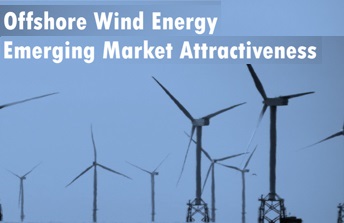 With more than US$ 647 million of foreign direct investment in offshore wind project development and domestic supply chain ramp-up at stake, Taiwan risks losing its mantle as one of the hottest offshore wind energy markets in the world. At the heart of this is the change in the feed-in tariff, which could face a steep reduction.
With more than US$ 647 million of foreign direct investment in offshore wind project development and domestic supply chain ramp-up at stake, Taiwan risks losing its mantle as one of the hottest offshore wind energy markets in the world. At the heart of this is the change in the feed-in tariff, which could face a steep reduction.|
Country |
Installed capacity |
Under construction |
Consented capacity |
Proposed capacity |
Comments |
|
|
#1 |
USA |
30MW |
1.5GW |
38.8GW |
Still considered an emerging market with only 30MW installed, we anticipate continued focus thanks to the success of the Bureau of Ocean Energy Management auction in Massachusetts and pending auctions in New Jersey, New York and other states |
|
|
#2 |
Taiwan |
8MW |
229MW |
904MW |
13.8GW |
Recent policy changes on feed-in tariffs have the major developers in the market spooked, but with so much capital investment and foreign direct investment at stake, an amicable resolution is likely which will get the Taiwanese market back on track |
|
#3 |
Poland |
9.8GW |
While still in the midst of a tenuous political scenario and incumbent coal still dominant in the market, we remain confident that several GW will be exploited for domestic consumption and export to its Eastern European neighbours |
|||
|
#4 |
Japan |
29MW |
250MW |
6.1GW |
Recent policy moves to more fully exploit the wind resource potential of Japan leave the market poised to see an upturn in capacity additions with a particular focus on floating foundations |
|
|
#5 |
Vietnam |
205MW |
202MW |
408MW |
13GW |
Huge upside potential awaits a market with growing electricity demand. Some initial experience with installation of intertidal and nearshore projects puts many project developers, EPC contractors and OEMs in a strong position |
|
#6 |
Turkey |
1GW |
Significant wind resource lies unexploited with the Black Sea and the Sea of Marmara ideal for existing fixed bottom foundation technology widely used throughout Europe, but political and currency risks hold back major development |
|||
|
#7 |
India |
3.1GW |
Investigation into the exploitation of offshore wind resource potential remains ongoing with a commitment for 30GW of development by 2030, but no firm tender for offshore capacity has been issued yet |
|||
|
#8 |
Brazil |
11.2GW |
Watch for the Petrobras/Equinor relationship to potentially jump-start this market, but the political uncertainty which remains in Brazil coupled with the financial stability and health of Petrobras may have an impact on the pace of buildout |
|||
|
#9 |
Azerbaijan |
200MW |
While Azerbaijan may not be on many lists of top offshore emerging markets, the promise of the Caspian Sea resource could make the country a huge net exporter of renewable energy to neighbours Armenia, Georgia and Turkey |
|||
|
#10 |
Australia |
2GW |
The Star of the South project would move Australia into becoming a major global offshore wind energy market, but approvals for this endeavour remain mired in the queue |
Table 1. Emerging offshore wind market attractiveness
